

25th March 1886 - 15th May 1917. A chorister at St Paul's Cathedral who served in WWI with the Honourable Artillery Company and fell at Bullecourt.
The sword One of the first surprising things to happen was that I was told of John’s ceremonial sword which had been discovered in the States and whose collector had been in touch with the HAC to get it verified. I got in touch with Mark Cain, an American collector, who was able to tell me something about the actual sword and provide me with my first images. The sword was made by Wilkinsons in 1916 and left the factory in the September. They were quite simply the best swords of their day. Every detail has clues as to its owner and regiment. Honourable Artillery Company is written on it and the bomb motif is on the scabbard. More importantly, John had seen fit to have his initials stamped on it. Nearly 100 years later this was to help reunite it with the next generations of family and bring it home.
First TV appearance - February 2012 Not long after our first discussions, Sue Raftree, MoD official in charge of recovery of bodies and reuniting them with families from past to present day, got in touch to say they were currently involved in a programme with the BBC for ‘Inside Out’ and JHP was featured in the programme because they were really trying to find relatives. It was decided that this would make a fitting contribution to the end of the programme and so we arranged to be interviewed for the programme down at my cousin’s house in Hampshire. Her father, my dad’s brother, had been named after John and was still alive, so it was very fitting that he took part too
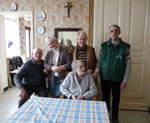
With Didier and his family
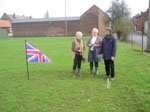
With Didier in his field by the post that marks where John fell
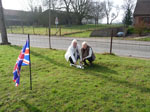
Laying roses for John with Jennifer
First visit to Bullecourt In March, my cousin, her husband and myself arranged to visit the farmer and the field where JHP had been discovered. On a chilly morning, we set off to Bullecourt, a village totally rebuilt after both wars, having been decimated. Didier Guerle greeted us and welcomed us into his house. His parents were excited about meeting the relatives of the ‘Capitaine’ and then Didier took us to the field which was the last place JHP had been alive. It formed part of the red patch on the Hindenburg line, a particularly gruesome place of conflict. Jen and I, laid white roses on the spot for our great uncle
Final resting place Didier also took us to the HAC cemetery in Ecoust-St-Mein where JHP was to be laid to rest amongst his other comrades. It was our first chance to visit the beautiful quiet cemetery surrounded by Poplar trees
Meetings at HAC - April 2012 Our first meeting with the HAC at Armoury House was full of emotion. Walking up the staircase as John would have done and seeing the rooms with which he was familiar meant a lot. By now we had a better picture being built up of John’s life. His musical beginnings and his war were starting to fall into place. I had seen where he died, seen the cemetery, spoken with my cousin Jackie about the research she had done; and now being allowed into the hallowed space of Armoury House was very special and sobering.
It became clear at this meeting that the HAC and the MoD were going to have a full military burial for John alongside the young Private who had last been seen with him and died on that day too. Private Elphick’s relatives had already been found and there were some other, unidentifiable remains which would be buried too as soldiers Known Unto God. At the meeting there was a discussion about the numbers of relatives who would be invited and a shocked silence when my cousin said there were at least 70 of us who could turn up. Later it was suggested that the usual number was 6! Throughout the proceedings, this became a matter of some conflict. How could we say that people were not entitled to come? Apart from my father’s brother, who was the last of the siblings in that generation and for whom John was his Uncle (although he was born after John died), the rest of us were cousins and all in the same generation and what’s more, really excited about the discovery and enthusiastic about taking part.
This photos shows just some of our family at a reunion in 2011 – by no means all!
Date for burial set It took several months to arrive at a burial date and in the end it was 15 months after we were ‘found’ before John was finally laid to rest on 23rd April 2013.
Words for the gravestone Our input was asked for with wording for the gravestone and this took several months of many emails between family members before we finally arrived at a version with which we were all happy.
Profoundly missed. Restored now to family. Lost for many years. Your battle is won’
A musical moment As we began to think about the service which would take a standard form but with some input of hymn choices from us, I started to wonder what John would want. Talking with my daughter one evening we had this conversation but came to no conclusions. The following day, an email from cousin Jackie arrived talking about how John had played and sung ‘Sunset and Evening Star’ to his mother and sisters before leaving for the Front for the last time. On doing an internet search, the very first video to come up was that of the St Paul’s Cathedral Choir singing that piece. The coincidence was actually shocking and thus this became an imperative choice for that service. Come what may, the four professional singers in the present family were going to sing this at the graveside for all those men. It became something of our own battle to get this to happen as we shall see!
Keep the home fires burning sung by members of the Hampton and Ember Choral Societies with soloist Janet Shell in the church at Bullecourt, directed by John Sutton.
Summer 2012 There were many co-incidences along this journey. Jen’s husband, John, always arranged a choir tour somewhere abroad, usually in France. That year they had already designated Arras as the destination and now arranged to sing in the church at Bullecourt, with pieces from WW1. I was invited to join them and what a special moment that was, singing for the memory of not only our great uncle but for his comrades too.
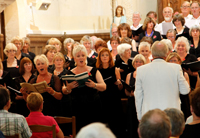
Jennifer and Janet singing a duet by Handel at the concert with the choirs in Bullecourt.
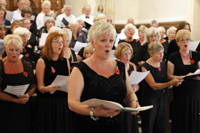
Janet singing in the concert.
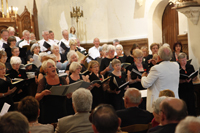
Jennifer singing in the concert.
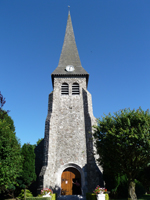
The modern day church at Bullecourt
A brutal February During February 2013, the sword arrived in London from Mark Cain and I went to see it in Armoury House where it had been delivered. A meeting was set up at the same time to discuss the burial service. It became clear that the military had a structure of service which they adhere to and that we could choose a hymn. Jerusalem had already been chosen by the Elphicks. I mentioned we would like to sing ‘Sunset and Evening Star as our tribute which did not go down well. The Major in charge curtly told me that this was a service for the military to bury their own not a family funeral. I pointed out that it was actually both of those things. They intimated that Prince Michael of Kent had expressed a wish to attend, which I surmised added to the formality. I insisted that somehow we would sing that for our relative, even if it meant waiting until the Prince and the entourage had departed. It was now critical this happened. I was deeply frustrated by that meeting and holding the sword of JHP I felt even more strongly that I had a duty to honour him for the family.
The old chestnut of our family being too large also came up with a cap on numbers for the receptions and who could talk to the press and when. It was a done deal and we were merely the recipients of their decisions. That both upset me and made me resentful. The trouble with army people is they get so used to issuing orders and to people following them without question, that they forget how to speak with civilians and are rather shocked when somebody questions them. I was left to convey all this to the family at large.
No longer a Captain Still reeling, a week or so later, I received a phone call from the MoD to tell me that JHP was not in fact a Captain after all and the rank on the gravestone would be that of Lieutenant. For 96 years he had been a Captain; he died leading his men and was named on the memorial at Arras as Captain. His men knew him as their Captain
It turns out that his substantive rank (ie what he was paid) was Lieutenant even though he was Acting Captain. According to the London Gazette, he had forfeited his Captaincy weeks before he died. The HAC had looked into this and found evidence in the Gazette of both him being a temporary Captain but never paid up as a full Captain. The Commonwealth War Graves Commission have to put the substantive rank on gravestones with no room for ‘acting’ ranks, and they were intransigent about this, despite the fact that subsequently I have seen gravestones with A/C beside the rank to indicate the rank others would have called them by at the time of death
Reader, we buried him Come what may, in April 2013 we arrived in France and were offered the opportunity to see the dressed coffins before the day itself.
On April 23rd 2013, we paid our last respects to John and his fellow comrades and finally laid him to rest in Ecoust-St-Mein in France, in front of the world’s media. It was a glorious day and the British Army, of course, had perfect attention to detail. The band surprised us with an arrangement of ‘Sunset and Evening Star’ as we waited for the coffins to arrive and we have learnt that they include it in all their Remembrance Day services ever since. Somehow I feel that is one of John’s lasting legacies. The ceremony was broadcast on the BBC rolling news along with interviews several of us had conducted. Afterwards, there was what is called the ‘wheel of death’ where you do a round of interviews and the finally we got to a reception.
Both the Elphicks and somebody from our family was asked to give a speech. I declined, but my name was emphatically called out and as I stepped into the space with an expectant silence, I just hoped some words would come out.
Somehow, they did and I gave probably one of the best impromptu speeches of my life. Looking around at the dignitaries and Prince Michael, still there, and the local mayor who was so anti British yet had wheedled his way into the reception, I felt a little bitterness about family members who had been excluded (and probably thought it was my doing) and I just remember that my final phrase was “He may have been buried as a Lieutenant, but to us he will always be our Captain”. There was an appreciable murmur and somebody said very distinctly, “Here, here”.
Post Burial The press gave JHP a good send off, and as we came back through France the following day, we bought the newspapers for posterity.
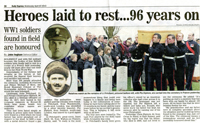
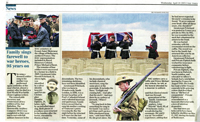
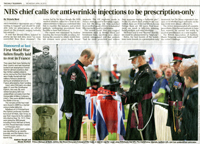
The press covered the burial extensively. Here are the articles from
The Daily Express, The Times and The Daily Telegraph.
Staying in the Spotlight John continues to keep himself in the spotlight. I was interviewed by Jeremy Paxman following the burial, for inclusion in his series which came out in January 2014 ‘Britain’s Great War.’
In October 2014 there was a BBC programme ‘The People Remember’ and my cousin Jen kindly invited me to take part with her. Then in October 2016, I found myself re-visiting the whole event for BBC Radio 4 in their programme series ‘Soul Music’. I was talking about Jerusalem and the profound effect of that hymn in its centenary year.
We thought things had quietened down, but JHP had one more idea for us! Bringing his story full circle, we go back to St. Paul’s Cathedral, where it all began.